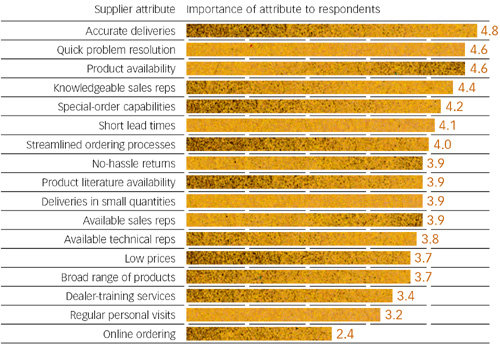In addition to staying abreast of all the new product and brand changes themselves, 85 percent of survey respondents indicated that their location’s salespeople are important in the effort to help their pro customers make decisions about the types and brands of building products they choose for their projects. “The importance of our sales-people in recommending products and brands continues to grow,” says Nisbet Brower’s Scheper, explaining that builder consolidation and brand recognition among contractors and homeowners only increases the value of dealer sales reps in product selection.
“With most products, there are four or five brands out there pushing themselves,” agrees Rhatican. “But it really comes down to what the yards want to keep and promote.” Thus, meeting service requirements within the distribution network is paramount to building product manufacturers, as well. “The salespeople at the dealer level are critical,” confirms Nowatarski. “They are our most important ally because they are selling and working with the builders and remodelers. They are establishing the relationships and have to have the confidence in our product.”
According to the survey, an average of 80 percent of sales in any given product category come from what a dealer considers its “primary brand”—and pushing that brand comes down to the sales force. On average, salespeople recommend specific brands of products nearly two-thirds (61.9 percent) of the time they work with customers, and are introducing new products or brands almost half the time (45 percent) that they interact with their contractors. “The dealer outside sales reps are one of the best avenues to get to the end user,” explains Ralph Bruno, vice president of sales and marketing for Moosic, Pa.–based AZEK Trimboards. “We have over 1,200 yards in the nation stocking AZEK, and I can’t think of one in our network that stocks AZEK and another brand of cellular PVC trim—they have been very brand loyal.”
Mike Derby, general manager of single-unit Dean Lumber in Holly-wood, Md., says that brand loyalty is in the pro dealer’s best interest, as well. “If you bounce around a lot from vendor to vendor to vendor, you lose the communication, you lose the people that you have formed relationships with, and there’s no sense of commitment,” he says. “There’s nothing wrong with change, but once we get in with a product and we are satisfied with the quality and the service, we tend to stick with it.”
Visitation Rights To assist in securing a brand-of-choice spot, vendors are jockeying to get some personal face time with dealers and distributors. According to the study, 86 percent of the respondents have at least one vendor visit each month; establishments whose primary business is building material dealer/lumberyard see the most face time, hosting an average of 12.4 vendors at their locations each month.
New product presentations top the list (73 percent) when it comes to generating interest in a visit, according to the study, outpacing exclusivity opportunities (55 percent), comparisons with competitive products (52 percent), and information on the profitability of selling a product (50 percent) (see “Visiting Time,” below). “A salesman’s time is very valuable,” explains Rhatican. “We look at the vendor’s services, we look at the product, and we make an educated guess whether it is worth putting on the schedule, so manufacturers need to have a real compelling argument.”
According to Derby, as a vendor’s commitment to its dealer network grows, so does the depth, scope, and frequency of meetings. “With our true vendor partners, we have quarterly meetings that involve not just product knowledge, but business planning as well,” he says.
That value-adding partnership mentality is beginning to creep into actual manufacturer sales calls in the field, as well, with more than half of the study participants saying that building product vendors have called on their locations’ core contractor customers in the past 12 months. The vast majority of these visits (84 percent) have been joint calls with both the dealer and manufacturer sales representative present. “We don’t try to do contractor calls in isolation,” says Boise Building Solutions’ Huston. “But we are in front of a lot of people [in the industry] every day. The bottom line is that you have to communicate, communicate, communicate to everyone in the channel what you are doing and what your goals are during visits with contractors.”
Overall, 59 percent of survey respondents prefer that vendors make joint calls on their core customers, compared to 20 percent who prefer that the vendor make a solo trip and 21 percent who have no preference. “Joint calls are very important to us because the manufacturers have the expertise that you need to secure product conversions, especially among big builders,” says Scheper. “And when you are going in to talk to the big builders, you want the big guns.”

